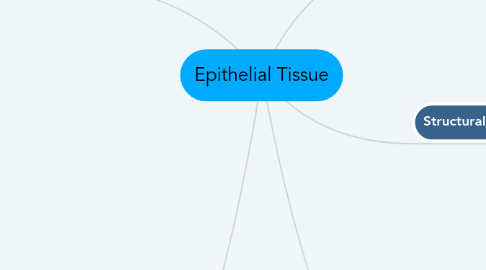
1. Meanings of Name Parts of Epithelial Tissues
1.1. Simple
1.1.1. 1 layer of cells
1.2. Stratified
1.2.1. 2 or more layers of cells
1.3. Squamous
1.3.1. Nucleus (in top layer of cells if stratified) is flat
1.3.2. Cell also looks more flat
1.4. Cuboidal
1.4.1. Nucleus (in top layer of cells if stratified) is round
1.4.2. Cell looks like it is cubed in shape
1.5. Columnar
1.5.1. Nucleus (in top layer of cells if stratified) is streched
1.5.2. Cells look more stretched, column like in shape
1.6. Pseudostratified
1.6.1. Nucleus are in different areas of a columnar type tissue
1.6.2. The nuclei are not neatly lined up
2. Specific Characteristics of Each Epithelial Tissue
2.1. Simple Squamous Epithelium
2.1.1. Located in blood vessels and mesentary
2.1.2. Function: allows materials to pass through by diffusion and filtration
2.1.3. Function: secretes lubricating substance
2.2. Simple Cuboidal Epithelium
2.2.1. Located in ducts (a passageway) and secretory portions of small glands
2.2.2. Located in kidney tubules
2.2.3. Function: secretes and absorbs
2.3. Simple Columnar Epithelium
2.3.1. Located in smooth (nonciliated tissues) in the digestive tract
2.3.2. In lab located in the small intestine
2.3.3. Function: absorbs; it also secretes mucus and enzymes
2.3.4. Goblet cells secrete mucus in the small intestine
2.4. Pseudostratified Ciliated Columnar Epithelium
2.4.1. Found in ciliated tissue that lines the trachea
2.4.2. Found in much of the upper respiratory tract
2.4.3. Function: secretes mucus; ciliated tissue moves mucus (mucus traps dirt)
2.4.4. Function: cilia act as sweepers to move the mucus and get rid of it
2.5. Stratified Squamous Epithelium
2.5.1. Lines the esophagus, mouth, and vagina
2.5.2. Found in the epidermis of the skin
2.5.3. Function: protects against abrasion
2.6. Stratified Cuboidal Epithelium
2.6.1. Found in sweat glads, salivary glands, and the mammary glands
2.6.2. Function: protective tissue
2.7. Stratified Columnar Epithelium
2.7.1. Found in the male urethra
2.7.2. Found in some glands
2.7.3. Function: secretes and protects
2.8. (Stratified) Transitional Epithelium
2.8.1. Lines the urinary bladder, urethra, and ureters
2.8.2. Function: allows the urinary organs to expand and strech
2.8.3. Function: protects
3. What is it?
3.1. One of the 4 main tissues
3.2. A tissue that covers/lines parts of our body, like the inside of hallow organs, and the skin surface (epidermis)
3.3. Cells are close together in this tissue
4. Structural Characteristics
4.1. Innervation- has nerves
4.2. Connectlve tissue supports epithelial tissues
4.3. There is little or no intercellular space between cells
4.4. The cells are closely bound together by cell junctions
4.5. All epithelial tissues are polar
4.6. Avascular- does not have blood vessels
5. Special Contacts
5.1. Desmosome
5.1.1. Acts as interlocking fingers
5.1.2. Strongest connection
5.1.3. Resists tension (pulling)
5.2. Tight Junctions
5.2.1. Proteins sew the plasma membranes together
5.2.2. Prevents leaking between cells
5.2.3. Found in the apical area of the epithelial tissue
5.3. Gap Junctions
5.3.1. Go from one cell to another through a small passageway
5.3.2. Like a doorway going from one room, into another
5.3.3. Also called a hydrophilic channel
5.3.4. Passageway between plasma membranes

